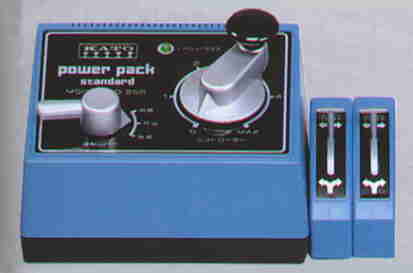 Kato
basic controller with point control switches plugged in.
Kato
basic controller with point control switches plugged in.Kato model train controllers
> main > modelling > control > kato control system
Kato offers a range of model railway controllers, including a cab-style controller, all items plug together with Molex-style plugs and sockets. Overall the system is very much like the system used by Tomix, but there are some differences.
Train controllers
The latest Kato catalog lists 5 different train controllers:
# 22-010 is Kato's basic controller. It has a controlled 0-12V DC output @ 700mA and a fixed 17V AC output @ 100mA. It has a control knob for speed and a lever-type switch to switch the running direction of your train. It has an LED power indicator. Switches for points can be plugged in at the right-hand side of the controller, using some kind of stud button for both mechanical and electrical connection.
 Kato
basic controller with point control switches plugged in.
Kato
basic controller with point control switches plugged in.
New basic controller
# 22-050 and # 22-052 Is Kato's cab-style controller. This is a very impressive (and expensive) piece of equipment, with seperate brake and accelarator controls, lots of adjustment controls, meters and even a recess for a pocket watch! Ref. 22-052 is a seperate transformer that provides power for the ECS-1 main unit. The controller can also be used with any other seperate 12V DC @ 3 Amps power supply.
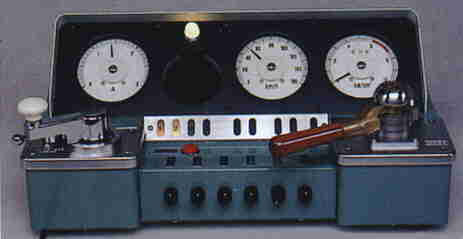 Kato
ECS-1 cab-style controller
Kato
ECS-1 cab-style controller
# 22-060 (controller) and # 22-080 (power supply) are Kato's intermediate controller, part of a modular system. Finished in a nice greyish green these controllers look very stylish and well made. These items are part of a system, where Kato has announced more controllers, a high-frequency lighting system was available, but withdrawn later. More on this system below.
Point control
Kato's points are of the 'EPL' type, which means that they use a single solenoid to throw the turnout. The direction of the current through the solenoid determines the direction that the blades will move. The point motors should be energised momentarily, to prevent them to burn out. To control thier turnouts, Kato has a switch in their range, ref. #20-500. This switch has the stud buttons which enable the switch to be plugged-in directly into a Kato train controller. A seperate adapter is available for those who have a differrent source of accessory power. The point control switch has a Molex-style connector in which the plug on the point motor lead plugs in, this is a very easy to understand method of wiring, very similar to the system used by Tomix, but the Kato wiring is of a heavier gauge with better connectors.
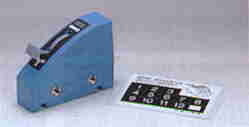 Kato
point control switch
Kato
point control switch 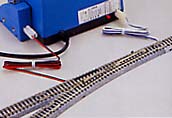 and how to wire Kato turnouts (just plug in)
and how to wire Kato turnouts (just plug in)
Kato modular controller system
Kato came with the idea of a modular train control system, where power supplies and controllers are in seperate housings that can easily be joined to form a complete controller system. Kato had proposed a whole product line of this system, but only a few items made it to the market. All units have stud button contacts on both left and right-hand sides. These buttons are used to form a busbar through all units to make wiring almost obsolete. Point control switches can also be plugged into the stub buttons. The units listed below where available from about 1992 to 2002.
# 22-080 Power supply (KM-1) This is the heart of the modular system. This power supply unit has an output of 12V fixed DC @ 2 Amps and can be paralleled for a 4 Amp outputr @ 12V DC, making it suitable for large-scale models or multiple-loco operations in H0 scale. Outputs are lovcated on the rear of the unit (Molex type) or on the sides (stud button type) for easy wiring.
 KM-1
Modular system power supply
KM-1
Modular system power supply
# 20-060 Train controller (KC-1). A controller box without internal transformer, capable of providing 3 Amps controlled 0-12V DC with a suitable power suplly (2 x KM-1)
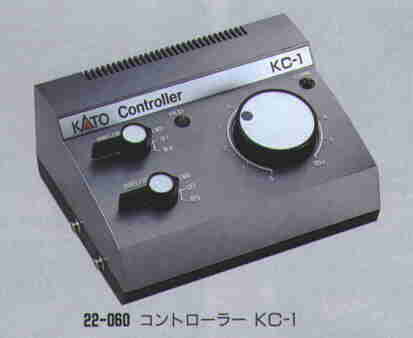 KC-1
Train controller
KC-1
Train controller
# 22-100 Lighting unit (KU-1) A high-frequency AC lighting unit. This unit provides high-frequency AC for constant lighting of your model trains. The unit has an adjustable HF-AC voltage and two direction switches. This unit has to be put between the output of your controller and the layout and has stub-button busbars to connect all modular control system devices together.
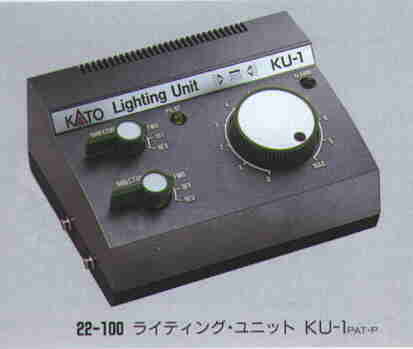 KU-1
HF AC constant lighting unit
KU-1
HF AC constant lighting unit
Proposed units that never made it:
Not all units that Kato had in mind in the early 90s had made it to market. Below is a list of units that were proposed, but never where introduced.
# 22-070 KP-1 Point controller. A box with several switches to control turnouts of the Kato Unitrack type. Unit was designed to have point position indicator LEDs. Unclear is how many points this box was meant to control.
# 22-061 KC-2 Two lever train controller. A cab-style controller in the modular design. Again a maximum load of 3 Amps (with 2 KM-1 power supplies) Unit was desingned with accelerator and brake levers as in a real train. Unit was more or less 'overtaken' by the ECS-1 'super controller'.
# 22-071 Accessory switch box. A control box to switch several accessories like lights, animated sceneries etc.
# 22-090 Meter unit KI-1. A unit with Volt and Amp meters to be used with both KC-1 and KC-2 controllers. Add meters to your controller to keep an eye on the performance of your models. Meters can give indication of overheating and short circuits before thing go really wrong, and that's why many modellers of older fashion like to have meters on their controllers.
New controllers
Over the years Kato have renewed their controller range. All controllers now have a seperate 'wall wart' type external power supply that can run on all usual mains voltages.
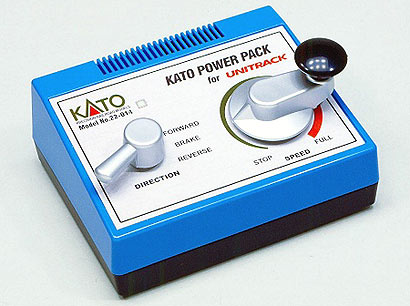 22-014 standard power pack (photo: Kato)
22-014 standard power pack (photo: Kato)
#22-014 now is the standard Kato power pack, rated @ 500 mAmps 0-12 v DC, the unit has push-nutton style connector on the right-hand side to connect with Kato point controllers.
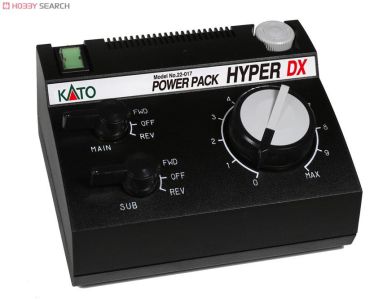 22-017 Hyper DX power pack (photo: Kato)
22-017 Hyper DX power pack (photo: Kato)
#22-017 is Kato's Hyper DX power pack, rated @ 1 Amp, 0-12 DC. The unit has an extra output that could be used on a reverse loop, wye or turntable. A adjustment knob enables you to give your train a smooth start (compare with the ring on the Tomix controller) and constant lighting. On the righ-hand side there are again the push-buttons to connect Kato's point controllers.
2020 Update
All off the controllers shown above
(apart from the point control switches) are no longer made. They have
been replaced with a new 'Standard SX' controller, that has a seperate
power supply. You haver the choice of two different power supplies, one
for N-scale and one for HO, the latter has a higher output voltage and
also porvides more amps for your power-hungry HO locomotives. The same
power supply is used for the 'Smart Controller' shown below. The
Standard SX controller has a PWM waveform to give you smooth control
with most locos and MUs.
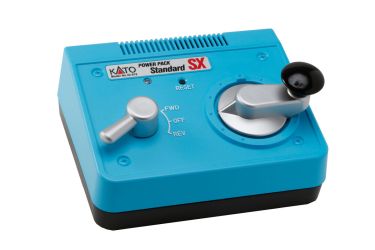 New 'Standard SX' controller (photo: Kato)
New 'Standard SX' controller (photo: Kato)
Smart Controller
From late 2018 Kato offers a Smart Controller that is operated by an app on your mobile phone (iOS or Android). It could be used with or without Kato's sound system. It simply connects via Bluetooth, have the app installed and off you go!
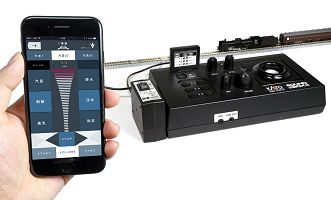
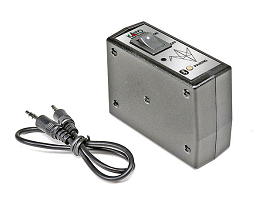
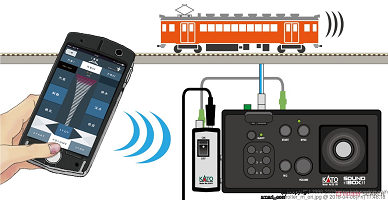 Kato's Smart Controller, with Soundbox, the controller and setup (photo: Kato)
Kato's Smart Controller, with Soundbox, the controller and setup (photo: Kato)
Kato Digital
Kato was one of the first manufacturers that offered a digital control system. In those days there was no real standard, and the Kato system was propiatry as any other system of those days. More details on this Kato Digital page.
Obsolete train controllers
In earlier years Kato offered many more controllers, all of these are obsolete now
# 22-001 Battery controller. Not really a controller, this little orange box, it holds 4 1.5V batteries and a forward-off-reverse switch. Output is 6 Volts without any speed control, this is not suitable for even the lowest standards in railway modelling.
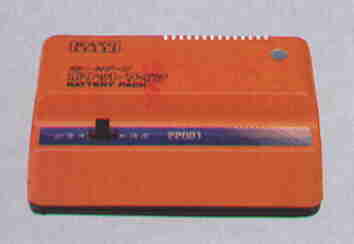 Kato
battery box
Kato
battery box
# 22-020 DeLuxe controller, a more upmarket version of the 22-011 basic controller. Output is 0-12V controlled DC @ 800mA and 17V fixed AC @ 300mA. This controller has two output sockets and two reverser switches. This is handy when you have a return loop or wye on your layout. This controller has a power output indicator in form of a 7 segment LED bar. Again this controller has stud buttons on the right hand side to provide power for turnout switches.
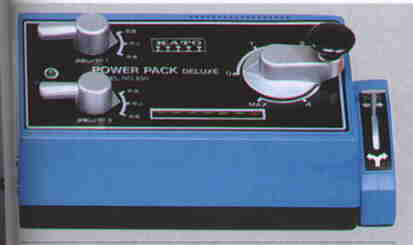 Kato
22-020 DeLuxe controller
Kato
22-020 DeLuxe controller
# 22-000 A very basic controller. 100V AC mains powered with a tapped transformer or resistor inside. Offers poor speed control by nature. Output is 0-12V DC @ 400mA with no extra output for accessories.
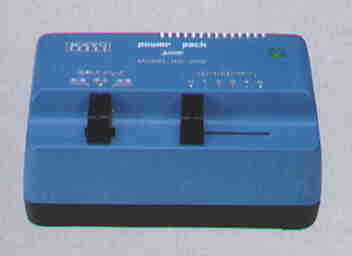 Kato
basic controller
Kato
basic controller
 Modelling
Modelling Layouts
Layouts Modeller's
Corner
Modeller's
Corner  Train Simulators
Train Simulators  Various
Various